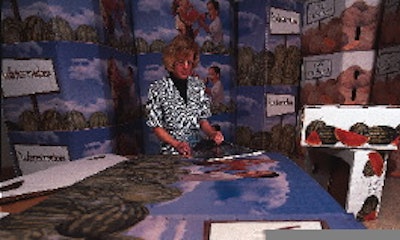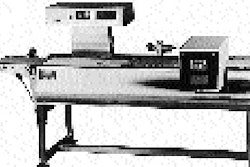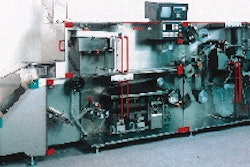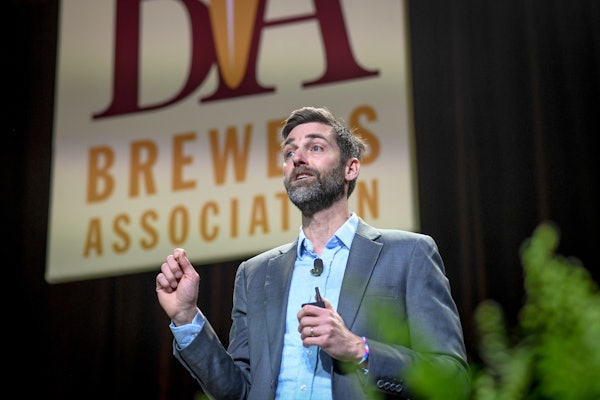With a primary emphasis on triple-wall corrugated bulk bins, Connelly Containers of Bala Cynwyd, PA, has built a specialized and profitable business for itself over the past decade. "Our niche has been in making 2ꯠ-pound containers for chemicals, parts, or ball bearings," says Tom Connelly, president of the 52-year-old privately held firm. "Often these boxes simply go from warehouse to manufacturing within a single facility, so there hasn't been that much need for graphics beyond something in one color that might say 'This side up.'" Lately, however, the heavy-duty boxes Connelly specializes in have begun to creep into club stores and supermarkets, often for watermelon, cantaloupe or other produce displays. Like everything else displayed in stores, such containers require appealing graphics. For the most part, that has meant either simple line art printed directly onto the corrugated board or, if greater impact is required, preprinted linerboard. Direct printing, while cost-efficient, often lacks graphic impact because it's limited to line art in one or two colors. For corrugated, direct four-color process printing has been accomplished only on small boxes. Preprinted linerboard, on the other hand, offers good printing quality, but typically requires longer runs, says Connelly. "You have to order in huge numbers to get the cost down to somewhere near reasonable, and even then it can add a lot to the cost of a bulk bin. An added problem is the size of these bins, which might measure 180 inches in circumference. Historically, the sheer dynamics of preprint equipment would require that such an image be printed in two pieces, which brings added work-in-process complications and costs." With the January commissioning of Connelly's #10 press, a new option is available: four-color process-printed graphics done in-line on corrugated sheets as part of the box-finishing system. Connelly employees call the new system the #10 press because they believe it is a "perfect 10." It was supplied by the German firm BGM, represented in the U.S. by BGM-USA (Barrington Hills, IL). Four-color applications "Four-color process printing was icing on the cake," says Connelly. He remembers how surprised his contacts at BGM were when he asked for four-color capability when he didn't actually have any four-color business at the time. "We told them we wanted to be ahead of the market," he says. "We knew we weren't going to have a new-installation opportunity like this for a long time, so it made sense to plan for the future. At the time I thought it might take two to four years to grow into the four-color business. Boy, was I wrong." It turns out that customers are genuinely excited about Connelly's new four-color capabilities, and they want to exploit it now, not in two to four years. Among them is watermelon grower and marketer B&K Farms in Rhodesdale, MD. "It's an eye-catching bin with beautiful graphics," says B&K's Bobby Harding. "We deal with major supermarket chains on the East coast, and a few in the west as well. We're hoping this package will increase our volume." As of mid-April, Connelly began delivering knocked-down printed blanks to Harding's Maryland warehouse, where the melons are repacked in the bins and shipped to stores. Harding says the new bins, made of 1괌-lb test triple-wall A-flute board, don't cost any more than last year's Connelly bins printed with line art in two colors. That seems odd when even Tom Connelly acknowledges that flexo printing plates, increased set-up times and huge amounts of ink are now part of the production picture. But these added costs are offset by the high throughput of the BGM system. Its mechanical speed is in the range of 6ꯠ units/hr, though actual running speed depends on how complex a job is, how much printing, die-cutting, scoring, and folding is done. At Connelly, production speeds are anywhere from 2ꯠ to 4ꯠ units/hr. Measuring approximately 210' from sheet infeed to the automated stacking station at the other end, the BGM system incorporates at least 13 major components or modules. These include prefeeding, feeding, four flexo print stations, pre-creasing, two slotting stations, die-cutting, folding, gluing and stitching. An automatic stacking station at the end of the line ensures that finished knocked-down boxes are neatly palletized for removal to warehouse by forklift. Biggest system yet BGM has built similar four-color systems for customers in Europe, but never one capable of handling sheets wider than 189". Connelly's CL 20/50 system accepts sheets as large as 216" across and 79.6" in the machine direction. With a special extension, sheets can measure as much as 98.8" in the machine direction. At the opposite end of the size spectrum, the Connelly system will accept sheets as small as 39.4" across and 27.5" in the machine direction. "Nobody in the world has done this at this size," says Tom Connelly. The sheer size of the machine presented certain challenges to some of Connelly's component suppliers. Sharp Steel (Emmaus, PA), for example, had to come up with a rotary die-cutting tool larger than any it had ever made before. Inks had to be customized, too. "With such a large print repeat length, considerable time elapses between deposition of ink on the printing plate and transfer to the substrate," says Tom Cavanagh, vice president of Environmental Inks and Coatings (Morganton, NC). "We had to be sure to formulate these inks so that they wouldn't begin to dry prematurely." Like other flexo inks used on corrugated substrates, drying is accomplished through absorption into the stock. In addition to being flat-out big, the CL 20/50 is powerful. It has to be, because soon it will have to fold, slot, and die-cut triple-wall corrugated board so heavy that it feels more like plywood than paperboard (see sidebar, p. 32). It was this ruggedness, and not a quest for superior graphics, that originally led Connelly to BGM in Germany. Four-color process printing became an objective only after initial conversations with BGM had begun. Prefeed is first The first station on the BGM system is a prefeed. It receives sheets in tall 6' stacks conveyed in on a powered roller conveyor supplied by C&M (Mitchel, IN). The stack is first mechanically centered in the middle of the machine. Rotating feed wheels then shingle individual sheets onto a prefeed table. A lead-edge feeder pulls down blanks by vacuum and rubber wheels propel them into the first of four print stations. Despite weighing in the range of 50ꯠ lb, the print stations are remarkably mobile. They automatically pull apart from each other when a printing plate must be mounted or removed. But they also slide in or out on tracks running perpendicular to the machine direction. This permits "sidetracking." If, for example, a two-color job is in production, the two print stations not in use can remain altogether out of the machine so that operators can clean them or begin makeready for the next run. Ink is fed into each print station from a 5-gal bucket through a chamber doctor blade system. An anilox roll transfers the ink to the rubber printing plate and finally to the board itself. "If the top liner is good quality paper," says BGM's Ralf Schiffmann, "there should be no problem with the quality of the print. The operators should be able to adjust the cylinders so that the printing plate merely kisses the board. Without good quality paper, however, you can encounter problems with the 'washboard effect.'" Immediately after the final print station is pre-scoring, followed by scoring. Then come two separate slotting stations that remove material so that top and bottom flaps may be formed. A rotary die-cutter, which cuts out hand holes or other features a customer may want, follows, and then the blank is folded. All that remains is gluing or stitching, or gluing and stitching combined. The BGM system incorporates two stitching heads. "Two 300-lb coils of wire feed one front and one back stitcher," says BGM-USA's Craig Farr. "If the stitch lap is twelve inches or less in width, only one head fires. Otherwise, both do." Folding rails, slotting heads, infeed gates, stitching heads and just about everything else on the system is controlled automatically by an operator entering information at the control panel keyboard. The information flows through what BGM's Schiffmann describes as "100 motorized and CNC [computerized numerical control] axes" to set individual components for whatever job is at hand. The installation of the BGM system meant the elimination of two flexo/folder/gluers at Connelly and several off-line stitchers as well. "We brought the new machine in with about fifty to sixty percent open capacity," says Connelly. "We kept one large flexo/folder/gluer and some off-line stitching machines. We could have eliminated all that as well and put all our volume on the BGM. But that would have left us with only twenty percent open capacity on the BGM. Instead, we decided to keep that other flexo/folder/gluer and see if we might occupy the open capacity on the BGM with new, value-added jobs. It now looks like that was the right way to go." To provide some insight into how "voracious" the new system is, Connelly says his firm's corrugator is typical of corrugators in other box plants in producing about 10 tons/hr. But while other box plants might have four or five finishing lines to process those 10 tons/hr, Connelly's BGM system alone can process about 25 tons/hr. "As a result," he adds, "we may be a net buyer of board from the outside as we get into our busiest part of the year and our business picks up." And the price tag for all this wizardry? Installation and engineering prep work alone-sidetracking rails, new electrical power plant, new air supply system for pneumatically driven components-was about $750ꯠ. And then there was the BGM equipment at $7 or $8 million. Says Tom Connelly to any who may be thinking of installing a similar system, "You'd better have a mindset of $10 million plus."
























